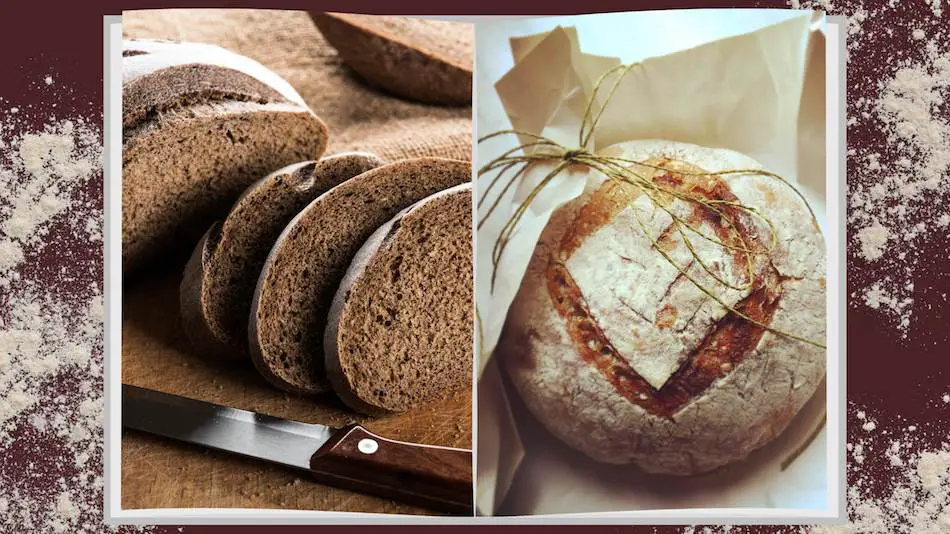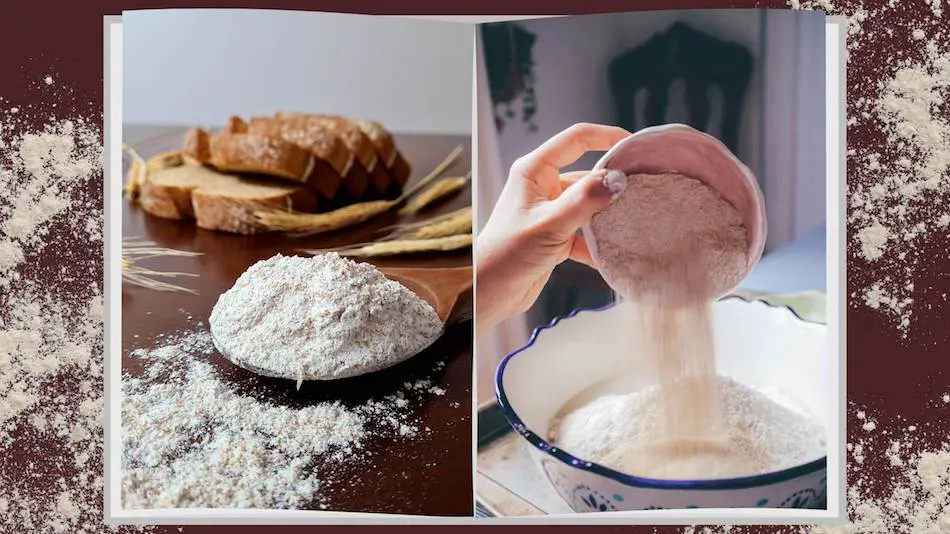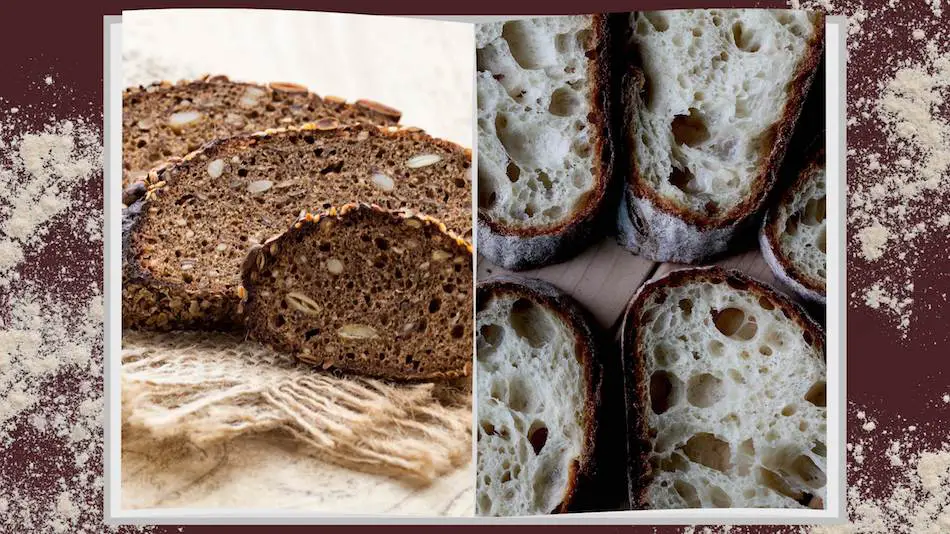
Rye and sourdough bread are two popular types of bread that are known for their distinct flavors and textures. In this article, we will compare these two types of bread and discuss the differences between them. We will also talk about the different flours and ingredients used to make rye and sourdough bread, as well as their nutritional content. By the end of this article, you will have a better understanding of the characteristics and differences between these two types of bread.
Rye bread and sourdough bread are both types of bread that have some differences in their ingredients, flavor, and texture. Rye bread is made with rye flour, which gives it a slightly sour flavor and a dense, heavy texture. In contrast, sourdough bread is made with a combination of rye and wheat flour, which gives it a tangy, sour flavor and a more airy, light texture. Additionally, rye bread is fermented using traditional yeast, while sourdough bread uses a wild yeast fermentation process. This difference in fermentation contributes to the unique flavor of each bread. In terms of nutritional content, rye bread is higher in fiber and lower in gluten, while sourdough bread is higher in protein and gluten.
Four Main Differences
- The type of flour used: Rye bread is made with rye flour, while sourdough bread is made with a combination of rye and wheat flour.
- The fermentation process: Rye bread uses a traditional yeast fermentation process, while sourdough bread uses a wild yeast fermentation process.
- The flavor: Rye bread has a distinctive, slightly sour flavor due to the rye flour, while sourdough bread has a tangy, sour flavor due to the wild yeast fermentation.
- The texture: Rye bread is denser and heavier than sourdough bread, which has a more airy, light texture.
- The nutritional content: Rye bread is higher in fiber and lower in gluten than sourdough bread, which is higher in protein and gluten.
1. They Use Different Flour

Rye bread is typically made with rye flour, which is a type of flour made from ground rye grains. This flour has a distinctive, slightly bitter flavor and a coarser texture than wheat flour. Rye bread can also be made with a combination of rye flour and whole wheat flour, which gives the bread a heartier flavor and texture. Sourdough bread is typically made with all-purpose flour or bread flour. All-purpose flour is a type of flour that is made from a blend of hard and soft wheat and has a medium protein content, while bread flour is made from hard wheat and has a higher protein content. These types of flour are ideal for making sourdough bread because they help the dough to rise and give the bread a chewy texture.
2. They Taste Different
Rye bread and sourdough bread can have different flavors. Rye bread has a distinctive, slightly bitter flavor that comes from the rye flour used to make the bread. This flavor is often balanced out with the addition of sweeteners like honey or molasses. Sourdough bread, on the other hand, has a tangy, slightly sour flavor that comes from the fermentation process used to make the bread. This sour flavor is a hallmark of sourdough bread and is what gives it its name. In addition to these distinctive flavors, both rye bread and sourdough bread can be flavored with herbs, spices, seeds, and other ingredients to add complexity and depth of flavor.
3. Both Breads Have A Different Texture

Both rye bread and sourdough bread can have different textures. Rye bread is typically denser and heavier than sourdough bread because of the properties of rye flour. Rye flour has a lower gluten content than wheat flour, which means it doesn’t rise as much and the finished bread has a denser texture. Sourdough bread, on the other hand, is typically lighter and airier because of the way the dough is fermented and the fact that it is made with wheat flour, which has a higher gluten content. This allows the dough to rise more and gives the finished bread a lighter texture.
4. They Have Different Nutritional Content
The nutritional content of rye bread and sourdough bread can vary depending on the specific ingredients used to make the bread. In general, however, rye bread is typically considered to be more nutritious than sourdough bread because it is made with rye flour, which is high in fiber, vitamins, and minerals. Sourdough bread, on the other hand, is made with wheat flour, which is lower in fiber and nutrients than rye flour. Additionally, the fermentation process used to make sourdough bread can cause some of the nutrients in the flour to be lost. This means that, overall, rye bread is typically considered to be more nutritious than sourdough bread.
What’s Easier To Bake? Sourdough Or Rye?
The difficulty of making bread can vary depending on the recipe and the experience of the baker. In general, however, sourdough bread is considered to be more difficult to make than rye bread because it requires a starter, which is a mixture of flour and water that is allowed to ferment and develop wild yeasts. This starter is used to leaven the dough and give sourdough bread its characteristic tangy flavor. Making a starter can be a time-consuming process and requires a certain level of expertise. In contrast, rye bread can be made without a starter and often uses commercial yeast, which is easier to work with than a starter. This means that, for some bakers, rye bread may be easier to make than sourdough bread.
Which Bread Has More Carbs?
It is difficult to say which type of bread has less carbs without knowing the specific recipe used to make the bread. In general, however, rye bread is typically considered to be lower in carbs than sourdough bread because it is made with rye flour, which has a lower carbohydrate content than wheat flour. Sourdough bread, on the other hand, is typically made with wheat flour, which has a higher carbohydrate content than rye flour.
Also, the fermentation process used to make sourdough bread can cause some of the carbohydrates in the flour to be broken down, which means that the finished bread may have slightly fewer carbs than the same bread made with unfermented dough. To determine the exact carbohydrate content of a particular type of rye or sourdough bread, it is best to consult the nutritional information provided by the manufacturer.
Which Bread Is More Fattening?
Again, it’s difficult to say which bread is more fattening recipes vary. However, bread is not considered a fattening food because it is made with mostly low-fat ingredients like flour, water, and yeast. Rye and sourdough bread can both be made with a variety of different ingredients, including fats like butter or oil, which can increase the fat content of the finished bread. However, the amount of fat used in a particular recipe can vary greatly, so it is difficult to say which type of bread is more fattening without knowing the specific ingredients used to make it. To determine the fat content of a particular type of rye or sourdough bread, read the nutritional information on the packaging, or find a low fat recipe.
Which One Is More Popular?
I don’t have access to specific market data, so it’s hard to say which bread is more popular. Both rye and sourdough bread are popular in many parts of the world and have been enjoyed for centuries. Rye bread, in particular, has a long history and has been a staple food in many parts of Europe for centuries. Sourdough bread, on the other hand, is popular in many different parts of the world, including Europe, North America, and Australia. It is difficult to determine which type of bread is more popular because both rye and sourdough bread are enjoyed by many people and have their own unique flavors and textures.
Are Rye And Sourdough Artisan Breads?
Rye and sourdough bread are often considered to be artisan breads. Artisan bread is a term used to describe bread that is made using traditional methods and ingredients. This type of bread is typically handmade in small batches and is often made with high-quality, natural ingredients. Rye and sourdough bread are often considered to be artisan breads because they are typically made using traditional methods and natural ingredients. They are also often made by hand in small batches, which sets them apart from mass-produced breads made using industrial methods.
How To Make Sourdough At Home
Making sourdough bread at home can be a rewarding and satisfying experience, but it can also be challenging. The key to making successful sourdough bread is having a healthy, active sourdough starter, which is a mixture of flour and water that is allowed to ferment and develop wild yeasts. This starter is used to leaven the dough and give sourdough bread its characteristic tangy flavor. Making a starter can be a time-consuming process and requires patience and attention to detail. Once you have a starter, making the dough itself is relatively easy, but it does require some knowledge of bread-making techniques. Overall, making sourdough bread at home can be rewarding but it is not necessarily easy, especially for those who are new to bread-making.
What Do I Need To Make Sourdough At Home?
To make sourdough bread at home, you will need a few basic tools and ingredients. Here is a list of some of the things you will need:
- Sourdough starter: This is a mixture of flour and water that is allowed to ferment and develop wild yeasts. It is used to leaven the dough and give sourdough bread its characteristic tangy flavor.
- Flour: You will need flour to make the dough for your sourdough bread. All-purpose flour or bread flour are good choices for making sourdough bread.
- Salt: Salt is used to add flavor to the dough and help control the fermentation process.
- Water: You will need water to make the dough for your sourdough bread.
- Mixing bowl: You will need a large mixing bowl to combine the ingredients for your dough.
- Measuring cups and spoons: You will need these to measure out the ingredients for your dough.
- Baking sheet: You will need a baking sheet or loaf pan to bake your sourdough bread in.
- Oven: You will need an oven to bake your sourdough bread in.
- Baking stone (optional): A baking stone can help to create a crispy crust on your sourdough bread.
- Banneton (optional): A banneton is a basket that is used to shape and proof the dough before baking. It can help to give your sourdough bread a nice, even shape.
What’s A Sourdough Starter?
A sourdough starter is a mixture of flour and water that is allowed to ferment and develop wild yeasts. This starter is used to leaven sourdough bread and give it its characteristic tangy flavor. To make a sourdough starter, you will need flour (usually all-purpose or bread flour), water, and a warm, draft-free place to let the starter ferment. To make the starter, combine equal parts flour and water in a clean container and stir to combine. Cover the container with a cloth and let it sit in a warm, draft-free place for 24-48 hours, or until bubbles form on the surface of the starter. At this point, the starter is ready to use in sourdough bread. If you don’t plan to use the starter right away, you can store it in the refrigerator and feed it with more flour and water every few days to keep it alive and active.
Homemade Sourdough Recipe
Here is a basic recipe for making sourdough bread:
Ingredients:
- 1 cup sourdough starter
- 2 cups all-purpose flour
- 1 tsp salt
- 1 cup warm water
Instructions:
- In a large mixing bowl, combine the sourdough starter, flour, and salt. Stir until well combined.
- Gradually add the warm water to the flour mixture, stirring to form a sticky dough.
- Knead the dough for 10-15 minutes, or until it becomes smooth and elastic.
- Place the dough in a lightly oiled bowl and cover with a damp cloth. Allow the dough to rise in a warm place for 8-12 hours, or until it has doubled in size.
- Preheat your oven to 450 degrees Fahrenheit.
- Punch down the dough and shape it into a loaf. Place the loaf in a greased loaf pan and cover with a damp cloth. Allow the dough to rise again for 1-2 hours, or until it has doubled in size.
- Once the dough has risen, bake it in the preheated oven for 30-35 minutes, or until it is golden brown and sounds hollow when tapped.
- Allow the bread to cool completely before slicing and serving.
Other Ways To Bake Sourdough
Sourdough bread is typically baked in an oven, but there are a few other methods you can use to cook your sourdough bread if you don’t have an oven or want to try something different. Here are a few alternatives to baking sourdough in the oven:
- Grill: You can cook your sourdough bread on a grill, either over direct heat or indirect heat. To cook your sourdough bread on a grill, preheat the grill to high heat and place the dough on a well-oiled grill grate. Grill the bread for 3-4 minutes on each side, or until it is crispy and golden brown.
- Skillet: You can cook your sourdough bread in a skillet, either on the stovetop or in the oven. To cook your sourdough bread in a skillet, preheat the skillet over medium-high heat and brush the bottom with oil. Place the dough in the skillet and cook for 3-4 minutes on each side, or until it is crispy and golden brown. You can also place the skillet in the oven and bake the bread for 15-20 minutes, or until it is cooked through.
- Dutch oven: You can cook your sourdough bread in a Dutch oven, either on the stovetop or in the oven. To cook your sourdough bread in a Dutch oven, preheat the oven to 450 degrees Fahrenheit and place the dough in the Dutch oven. Cover the Dutch oven with the lid and bake the bread for 30-35 minutes, or until it is cooked through and has a crispy, golden brown crust. Alternatively, you can cook the dough in a Dutch oven on the stovetop over medium-high heat, using the lid to create a steamy environment that will help the bread to rise and develop a crispy crust.
How To Bake Rye At Home
To bake rye bread at home, you will need rye flour, water, yeast, and salt. You will also need a few basic tools and equipment, such as a mixing bowl, measuring cups and spoons, a loaf pan, and an oven. To make rye bread at home, combine the flour, water, yeast, and salt in a mixing bowl and stir to form a dough. Knead the dough for 10-15 minutes, or until it becomes smooth and elastic. Place the dough in a greased loaf pan and let it rise in a warm place for 1-2 hours, or until it has doubled in size. Once the dough has risen, bake it in a preheated oven for 30-35 minutes, or until it is golden brown and sounds hollow when tapped. Allow the bread to cool completely before slicing and serving.
Homemade Rye Bread Recipe
here’s a simple recipe for rye bread that you can make at home:
Ingredients:
- 1 1/2 cups warm water
- 1 tablespoon active dry yeast
- 1 tablespoon sugar
- 1 tablespoon vegetable oil
- 1 teaspoon salt
- 1 1/2 cups rye flour
- 1 1/2 cups all-purpose flour
Instructions:
- In a small bowl, combine the warm water, yeast, and sugar. Stir to dissolve and let the mixture sit for about 5 minutes, or until it becomes frothy.
- In a large mixing bowl, combine the rye flour, all-purpose flour, salt, and vegetable oil. Add the yeast mixture and stir until a dough forms.
- Turn the dough out onto a lightly floured surface and knead for about 5 minutes, or until it becomes smooth and elastic.
- Place the dough in a greased bowl, cover with a damp cloth, and let it rise in a warm place for about 1 hour, or until it has doubled in size.
- Preheat your oven to 375°F (190°C).
- Punch down the dough and shape it into a loaf. Place it in a greased loaf pan and let it rise again for about 30 minutes.
- Bake the bread for about 35-40 minutes, or until it is golden brown and sounds hollow when tapped.
- Let the bread cool in the pan for a few minutes before transferring it to a wire rack to cool completely.

